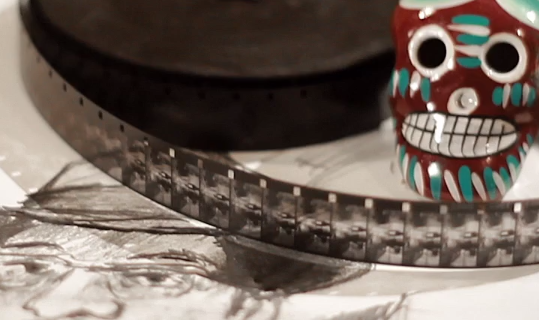Filmmaker, educator and film festival director Bart Weiss has produced Frame of Mind since 1995, a public television series serving up independent documentaries and shorts created by fellow artists in his home state of Texas. Generally a sporadic event occurring at odd times throughout the years, in 2014 “we decided to do a 13-week series and treat it like a real TV show,” he told Brief, “and actually promote it and get some good viewership.”
The first full series of Frame of Mind debuted on September 4 on the Texas public TV station KERA. Leading up to it, Weiss helped create an on-air promo that ran on the network as well as an audio promo for play on KERA’s public radio stations. He also hired Sai Selvarajan, an editor and designer for Dallas-based Lucky Post studio, to craft a show open that would, said Weiss, “get you into the mindset of the culture of film… The angst, the joy and the inspiration of the Texas filmmaker who creates the work you’re about to see.”
Selvarajan’s portfolio includes work on promos and commercials for brands ranging from Comcast SportsNet to Chrysler, as well as trailers for feature films such as NASH: The Documentary. But to tap into the spirit of Frame of Mind, he knew he would have to tap into a different side of himself. “It’s eclectic,” Selvarajan told Brief, “and many of the films are think pieces, not fluff. They ask a lot of the audience… I wanted [the opening] to be introspective but still encompass genres and a variety of films and ideas.”
To that end, Selvarajan went almost as introspective as one can, aiming to capture the soul of an independent artist by… actually capturing an independent artist, at work, caught up in the throes of creating his next masterpiece. He teamed with his friend and frequent collaborator, the designer and illustrator Johnny Rutledge, to execute a simple but powerful idea: Take Rutledge and the camera into the artist’s own, tiny backyard studio, give him paper and a drawing implement, and let him go at it.
The open begins with macro lens close-ups of Rutledge sketching. As it progresses, and the camera makes its way back to gradually reveals the drawing, old photos from estate sales, strips of film reel, a retro-looking Super-8 camera and other artistic ephemera creep in. Though he would later clean the footage up in post, Selvarajan created the brunt of the spot’s narrative in-camera, shooting individual strokes of the charcoal pencil, then adding some objects, then grabbing another stroke, and so on. “It’s like stop-motion,” he explained. “Every time we stopped the camera was like a cut. There’s a handmade element to it. We wanted to keep this as analog as possible.”

On a cursory viewing, these handmade visual elements, combined with a perfectly calibrated soundtrack courtesy of local band The Paper Chase, successfully reflect, and create anticipation for, the artistry to come. But at a deeper level, the memorabilia on display informs the open as well, both hinting at the individual whom we are watching work and telling the story behind the work of art itself. The drawing that emerges, of an older woman with horn-rimmed glasses, whose head seems to be literally exploding from the power of her camera, was culled from the photos that appear in the open, which in turn were culled from Rutledge’s own collection. As a result, the spot achieves the nifty trick of feeling both universal and utterly specific.

“All that we [as filmmakers] do starts up there and then we project it out to the world,” said Selvarajan. “It starts as a thought and then you formulate it into a word or a script. We used that as the basis of everything.”
Interspersed with the drawing action, astute viewers will observe footage of a turbulent sky and a translucent human body statuette. “We were interested in neurons,” explained Selvarajan, “and the synapses that fire. Where does inspiration come from? We started added these things to show the scientific side of it.”

All told, Selvarajan’s Frame of Mind opening has a “density” to it, said Weiss, that “doesn’t look like a promo from public TV… It has a texture to it and an aesthetic that is as indie as any of the episodes that will be preceding it. It has the soul of an indie filmmaker.”
Through his work curating Dallas VideoFest and other noteworthy film festivals in Texas, Weiss has ample experience working with artists to produce memorable promos that get viewers excited for what’s to come. “Promos can describe complex thoughts that people who are making the actual thing don’t even realize,” he said. “It’s not just something to put logos in but to contextualize everything that happened before… [to] create an environment where people can enjoy a richer experience with the content.”
Tags:













































__twocolumncontent.jpg)











